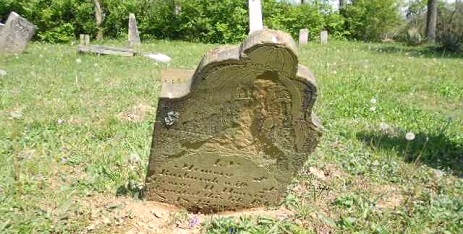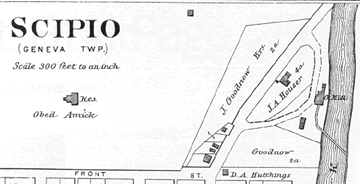
|
Barbara
(Miner) Houser |
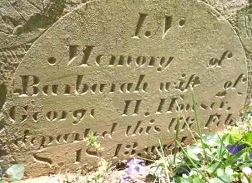 |
| Barbara's grave, 1843 - Brenda Cotterman Hines |
Barbara (Miner) Houser was born in 1816, probably at Sego, Perry County, OH, the daughter of Frederick and Elizabeth (Sechman) Miner Sr.
As a young woman, Barbara relocated to Fairfield County, OH, where she met her future husband.
On Feb. 4, 1833, when she was 16 or 17 years of age, Barbara was joined in the bonds of wedlock with George H. Houser (1813-1893), the son of Fairfield County pioneers. The nuptials were held in Fairfield County in a ceremony performed by the hand of Rev. William Thorn, a minister of the Gospel.
The couple is thought to have lived in or near Rushville, Fairfield County.
Their five children were Dorotha Houser, Jane Houser, Elizabeth W. Baker Dillow, Mary McMurray and Ann Maria Houser. Sadly, daughter Dorotha is believed to have died young, sometime prior to 1883.
The 1883 book, History of Fairfield and Perry Counties, Ohio, compiled by A.A. Graham, states that either George or his father erected the first grist mill in Walnut Township, "situated on Big Walnut Creek."
Tragically, after a decade of marriage, and at just age 27, Barbara died on Feb. 8, 1843. The cause of her death is unknown. She is buried in the Rushville-Pleasant Hill Cemetery. While her grave marker is listed on a survey of the cemetery published in 1984, it is now gone, or faded beyond recognition.
 |
| The Housers' marriage license, dated 1833 |
On
March 9, 1843, a month after Barbara's death, George wed his second bride, Ruannah "Rue Ann"
Stanton (1815-1902) in Fairfield County. A native of Baltimore, MD,
Ruannah is thought to have been a
cousin of Edwin M. Stanton, Secretary of War in President Lincoln's
Cabinet.

Book profiling George
The second marriage generated a family of seven more children, including three future physicians -- George Houser, Dr. James Alfred Houser, Dr. Solon K. Houser, Dr. Franklin Alexander Houser, Josephine Hortence Anthony, Clara Gertrude Draper Kiefer and Hattie Bell Hutchings. To see a gallery of photos of this second family, click here.
Jacob Piatt Dunn's 1919 book, Indiana and Indianans (Volume III), states that George "followed farming and milling. He was also a Free Will Baptist preacher, was a justice of the peace, and ... [a] postmaster...." George was appointed postmaster at Tiverton, Coshocton County, OH, on July 23, 1847. He served until May 4, 1848, when his successor was appointed. They later moved to Berkshire Township, Delaware County, OH, where in 1850 he worked as a miller.
By 1860, the family had moved again, to Washington Township, Franklin County, OH, where George earned a living as a sawyer. Daughter Jane, from the first marriage, was residing in his household that year at age 25.
Then, in 1863, the Housers moved to Indiana,
planting their home at Logansport, Cass County. Indiana and Indianans reports that son James (from the
second
marriage) spent his boyhood "in hard work and his advantages were confined to the
common schools. Between the ages of twelve and fourteen he was a boat
driver on the Miami and Erie canal from Cincinnati to Toledo." James
graduated from the Toledo Medical College in 1886, specialized in "diseases
of the brain and derangements of the nervous system," and in his lifetime
delivered more than 6,000 lectures on various subjects. Son Solon (from the
second marriage) "learned the miller's trade with his father," said
the 1893 book, Pictorial and Biographical Memoirs of Indianapolis and Marion
County, Indiana.
|
Above: Barbara's legible but leaning grave marker. Below: George's great grandson James Franklin Houser Jr. at the Scipio (IN) bridge, 1989 |
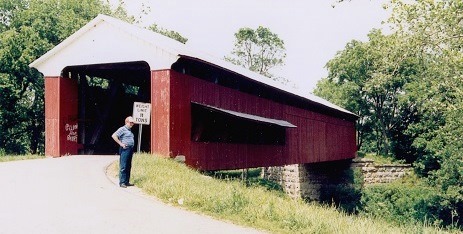 |
The Housers may well have migrated back and forth
between Indiana and Ohio, as the 1870 federal census enumeration shows them living in Mercer
County, OH.
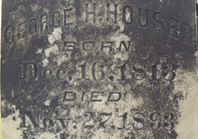
George Houser's grave, Scipio
In 1876, George and his sons bought a gristmill on Sand Creek at Scipio, near where the covered bridge was erected a decade later in 1886. The structure is nearly 150 feet in length and slightly more than 15 feet wide.
After buying the mill, the Housers promptly sold half their interest in the mill to James Howe for $1,600 and 80 acres of land, showing just how valuable the property was viewed. A local newspaper said "We think it well sold." The following year, George and his partner "put new weather-boarding on the east end of their mill."
The grist mill was never a very stable or lucrative enterprise. It was the subject of legal wrangling, including a lawsuit over the payment of the purchase price. Son Solon realized he had no future there. Said the Pictorial and Biographical Memoirs, "After following the business for 16 years at Scipio, Ind., he decided that a change would be beneficial and disposing of his milling interests in 1883 he began the study of medicine with his brother, Dr. J.A. Houser. Later he entered the Kentucky School of Medicine and graduated from that well known institution in June, 1892."
|
Location of the Houser mill, at the right hand edge of an 1884 county atlas, when owned by George's son James. Below: Helts Mill, 5 miles west of Scipio, which may resemble the Houser milll. |
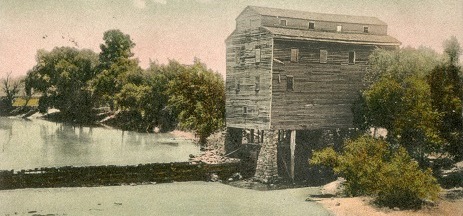 |
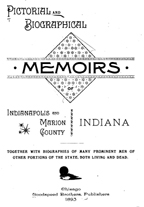 |
|
|
In April 1878, the mill was to be sold, but the Vernon
Banner said the effort "was a failure, owing to the fact that the Mill
was appraised at about double the value, and according to the statutes, it would
have to sell for two thirds of the appraisement, consequently there was not a
bid made for it." Later that year, in July, the county commissioner
placed an ad in the Banner, saying he would offer the property at a
public sale. But that sale failed, too, "for want of some one to buy
it." By October, however, the Banner said "Messrs.
Housers have got possession of the Goodnow Mill, and they are happy. The old
gentleman says that he is going to treat the people in such a way that they will
have to patronize him." But by December, the mill had been sold again at a
sheriff's sale, to one if its former owners, J.L. Goodnow.
The mill does not exist today, nor are ruins visible. Like others in the area, it may have burned, been dismantled for other uses, washed away in a flood, or fallen into disrepair.
George devoted much of his later life in Christian ministry, but found himself embroiled in controversy in the fall of 1879 when questioned on the authenticity of his license to preach. The matter was covered by newspapers in Fort Wayne and Columbus, IN. Reported the South Bend (IN) Tribune:
A queer state of affairs has been developed in the little town of Scipio, this state, and on the settlement of them depends the happiness or sorrow of a large number of married people. A few years ago Rev. George Houser, a Baptist minister, settled in Scipio and, like all ministers, was called upon to solemnize numerous marriages, and among them Thomas F. Chadwick and Melinda Renard and Thomas Aikens to Adeline Dixon. Last June Rev. Mr. Houser was arrested upon an information presented by the Prosecuting Attorney W.G. Holland, based upon the affidavit of Elias M. Thompson, a former justice of the peace and a prominent citizen and member of the Presbyterian church, charging him with failing to make proper returns of the minister's certificate of marriage, in the cases above referred to, to the county clerk, as required by law... Thompson made two affidavits, one each with reference to the marriage of the parties referred to, in which he alleges the fact that the said Rev. George Houser was not a licensed preacher, and consequently was acting without the forms of the law in attempting to solemnize the marriage rites. These cases were also presented to Mayor Cope by the prosecuting attorney upon information, but he declined to try them, and certified them to the circuit court. Meantime Houser had been again arrested and put under bond in both cases for his appearance in the Jennings circuit court. Rev. Mr. Houser declares that he has a license to preach, and at the proper time will produce it. If he does, it will be a great relief to the hundred or more couples whom he has married. But supposing that Rev. Houser has a license, how is it with hundreds of other ministers in this state who preach the gospel and officiate at weddings, and have no license to do so? What is there to make legitimate the marriages they solemnize? The subject is well worth investigating, and we advise all young people who stand up to get married in Indiana, when asked by the minister to show their license, to ask the minister in return to show his. This will be both safe and prudent, and there will be no trouble in the camp thereafter.
When son James was profiled in 1893 in the book Pictorial and Biographical Memoirs of Indianapolis and Marion County, Indiana, George was said to have been "a miller by occupation at an early period of his life, and also devoted many years to preaching. he now lives retired from active work."
At the time of his death at Scipio on Nov. 27, 1893, George was a preacher. The North Vernon Sun reported that his funeral "was very largely attended" but that son James was "on a lecturing tour in Missouri and "was unable to attend." James' two daughters and a son came in his place.
Ruanna died at Scipio on Sept. 8, 1902. The Vernon Sun said that "Dr. J.A. Houser and wife and Mrs. Herbert Hess of Indianapolis attended the funeral of the former's mother last Wednesday." They are buried together under a large, fancily decorated monument at the Scipio Cemetery.
George and Barbara are mentioned in the 1883 book, The History of Madison County, Ohio, published by W.H. Beers & Co., in a biographical profile of son in law and daughter, Alexander B. and Mary (Houser) McMurray.
~ Daughter Jane Houser ~
Daughter Jane Houser (1834- ? ) was born in about 1834 in Ohio.
She was about 9 years of age when her mother died. At the age of 16, in 1850, she dwelled with her father and stepmother in Berkshire Township, Delaware County, OH. When the federal census enumeration was made in 1860, Jane at age 25 continued to dwell in her father's household, now in Washington Township, Franklin County.
Jane accompanied her father and stepmother in a migration during the 1860s to near Coldwater, Gibson Township, Mercer County, OH, and was under their roof at age 36 when included in the 1870 U.S. Census. The census-taker marked that her occupation was to "help mother."
Alive in 1883, she was named in the book, History of Fairfield and Perry Counties, Ohio, compiled by A.A. Graham.
Nothing more is known.
~ Daughter Ann Marie Houser ~
Daughter Ann Marie Houser (1840- ? ) was born in about 1840 in Ohio.
Her mother died when Ann was a girl of just 3 years of age. At the age of 10, in 1850, she dwelled with her father and stepmother in Berkshire Township, Delaware County, OH.
She was alive in 1883 when named in the book, History of Fairfield and Perry Counties, Ohio, compiled by A.A. Graham.
Nothing more is known.
|
Copyright © 2000, 2002, 2004, 2006-2007, 2022 Mark A. Miner |
|
Pictorial and Biographical Memoirs title page courtesy of Google Books. |
